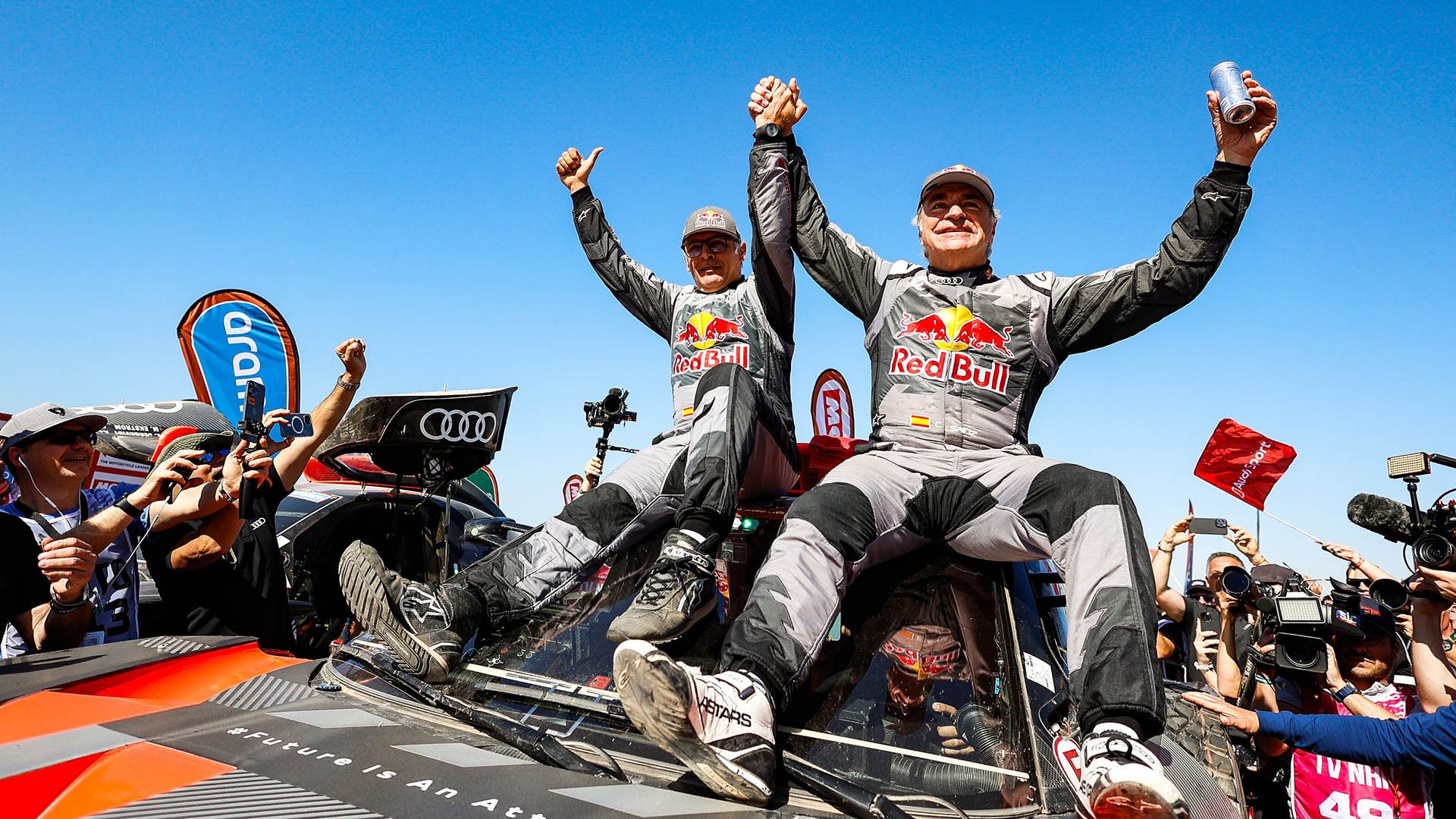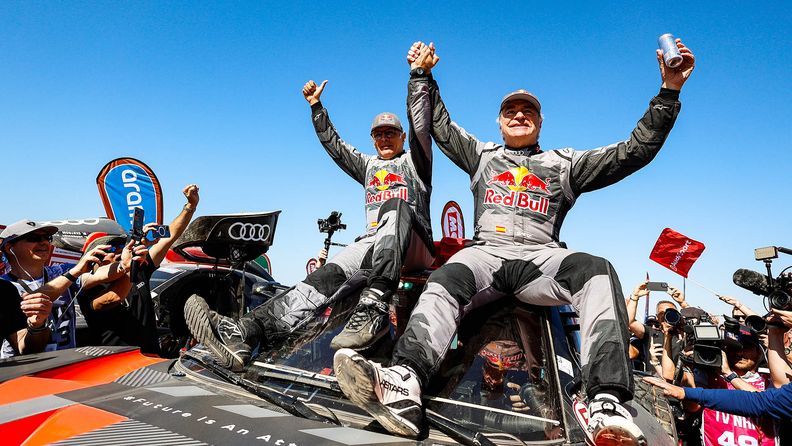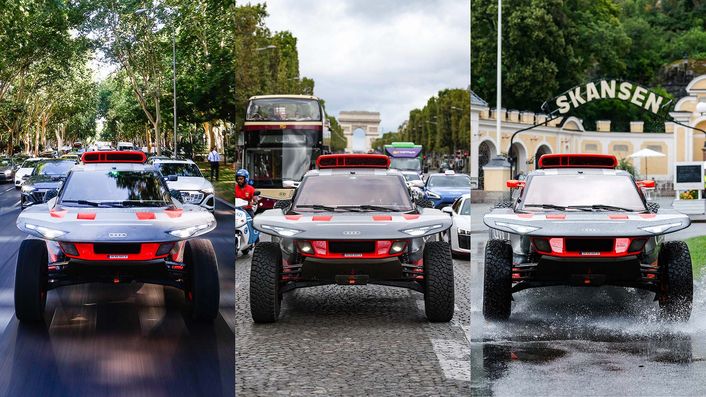
¹Audi RS Q e-tron, pictured above: This vehicle shown here is the Rally Dakar vehicle that is not available as a production model. Closed course, professional driver. Do not attempt.
¹Audi RS Q e-tron, pictured above: This vehicle shown here is the Rally Dakar vehicle that is not available as a production model. Closed course, professional driver. Do not attempt.
Test laboratory in the desert
The Audi RS Q e-tron¹ is the car that was developed by the brand with the four rings for one of the greatest challenges in international motorsport: the Dakar Rally. After two previous attempts, Team Audi Sport won the legendary event with Carlos Sainz and Lucas Cruz in 2024. The victory made motorsport history as the Audi RS Q e-tron¹ became the first car to win the Dakar Rally with an electric drivetrain² in combination with an energy converter².
¹This vehicle mentioned here is the Rally Dakar vehicle that is not available as a production model.
²The Audi RS Q e-tron combines an electric drivetrain with an energy converter system based on the TFSI engine and a generator.
¹This vehicle mentioned here is the Rally Dakar vehicle that is not available as a production model.
²The Audi RS Q e-tron combines an electric drivetrain with an energy converter system based on the TFSI engine and a generator.

Motor generator units (MGU)
3
One MGU on each axle and one as energy converter²
Acceleration
less than
4.5
seconds
from 0 to 100 km/h on loose surfaces
Top speed
170
km/h
limited by the ASO regulations
Audi RS Q e-tron, pictured above: This vehicle shown here is the Rally Dakar vehicle that is not available as a production model. Closed course, professional driver. Do not attempt.
²The Audi RS Q e-tron combines an electric drivetrain with an energy converter system based on the TFSI engine and a generator.
Audi RS Q e-tron, pictured above: This vehicle shown here is the Rally Dakar vehicle that is not available as a production model. Closed course, professional driver. Do not attempt.
²The Audi RS Q e-tron combines an electric drivetrain with an energy converter system based on the TFSI engine and a generator.
Highlights of the Audi RS Q e-tron¹

The distinguishing aspects of the Audi RS Q e-tron¹:
- Developed for the T1U class of the Dakar Rally’s regulations for vehicles with alternative drivetrains²
- Utilizes an alternative drivetrain concept²
- High-voltage battery is charged while driving via an energy converter²
- Three motor-generator units (MGU), one on each axle and one part of the energy converter²
- Futuristic vehicle that is in its second evolution stage
¹Audi RS Q e-tron, pictured to the left: This vehicle shown here is the Rally Dakar vehicle that is not available as a production model. Closed course, professional driver. Do not attempt.
²The Audi RS Q e-tron combines an electric drivetrain with an energy converter system based on the TFSI engine and a generator.
¹Audi RS Q e-tron, pictured to the left: This vehicle shown here is the Rally Dakar vehicle that is not available as a production model. Closed course, professional driver. Do not attempt.
²The Audi RS Q e-tron combines an electric drivetrain with an energy converter system based on the TFSI engine and a generator.

Innovative drivetrain concept²
Because there are no charging opportunities in the desert, Audi chose an innovative charging concept²: On board of the Audi RS Q e-tron¹, there is the 2.0 liter four cylinder turbo TFSI engine from the DTM. It is part of an energy converter² that charges the high-voltage battery while driving.
The drivetrain² of the Audi RS Q e-tron¹ is electric². The front and rear axles are both fitted with a motor-generator unit (MGU) from the Audi e-tron FE07³ Formula E car. Only minor modifications had to be made to use the MGU in the Dakar Rally.
A third MGU, of identical design, is part of the energy converter² and serves to recharge the high-voltage battery while driving. In addition, energy is recuperated during braking. The battery weighs about 370 kilograms and has a capacity of around 52 kWh.
¹Audi RS Q e-tron, pictured to the right: This vehicle shown here is the Rally Dakar vehicle that is not available as a production model. Closed course, professional driver. Do not attempt.
²The Audi RS Q e-tron combines an electric drivetrain with an energy converter system based on the TFSI engine and a generator.
³This vehicle mentioned here is the former Formula E vehicle that is not available as a production model.
¹Audi RS Q e-tron, pictured to the right: This vehicle shown here is the Rally Dakar vehicle that is not available as a production model. Closed course, professional driver. Do not attempt.
²The Audi RS Q e-tron combines an electric drivetrain with an energy converter system based on the TFSI engine and a generator.
³This vehicle mentioned here is the former Formula E vehicle that is not available as a production model.

Continuous development
The second evolution of the Audi RS Q e-tron¹ was developed for the 2023 Dakar Rally. It was lighter, more aerodynamic and had improved efficiency. The body was completely new and featured improved aerodynamics. It helped to lower the car’s weight and center of gravity. New operating strategies further improved the efficiency of the electric drivetrain². In the interior and when changing wheels, the driver and co-driver benefited from easier operation.
Ahead of the 2024 Dakar Rally, Audi analyzed the previous outings with the second evolution of the Audi RS Q e-tron¹, identified weak points and set clear priorities for further development. Five key topics were concentrated on by the development team: safety, reliability, comfort, performance and maintenance times. The hard work and dedication of Team Audi Sport paid off with victory at the 2024 Dakar Rally for Carlos Sainz and Lucas Cruz.
¹Audi RS Q e-tron, pictured to the left: This vehicle shown here is the Rally Dakar vehicle that is not available as a production model. Closed course, professional driver. Do not attempt.
²The Audi RS Q e-tron combines an electric drivetrain with an energy converter system based on the TFSI engine and a generator.
¹Audi RS Q e-tron, pictured to the left: This vehicle shown here is the Rally Dakar vehicle that is not available as a production model. Closed course, professional driver. Do not attempt.
²The Audi RS Q e-tron combines an electric drivetrain with an energy converter system based on the TFSI engine and a generator.
Design
in Detail



Audi RS Q e-tron, pictured in the images above: These vehicles shown here are the Rally Dakar vehicle that is not available as a production model. Closed course, professional driver. Do not attempt.
Audi RS Q e-tron, pictured in the images above: These vehicles shown here are the Rally Dakar vehicle that is not available as a production model. Closed course, professional driver. Do not attempt.
Technical data
| Audi RS Q e-tron¹ | |
|---|---|
| Vehicle type | Rally Raid Vehicle (Category T1U – alternative drivetrains²) |
| Chassis | Steel tube frame in combination with structural components in carbon/Zylon fiber composite |
| Drivetrain | All-wheel drive with electrically driven axles² |
| E-drivetrains² on the axles | One Audi MGU05 from Formula E per axle |
| Output |
Total system power under 286 kW (389 hp) |
| Transmission | One single-speed racing gearbox per axle |
| Battery | High Voltage Battery System (HVBS), approx. 370 kg (wet), lithium-ion cells, usable battery capacity approx. 52 kWh, charging with max. 220 kW (299 hp) while driven through energy converter² |
| Energy converter² |
2.0 liter four-cylinder turbo engine from the DTM coupled via a shaft with a generator (Audi MGU05 from Formula E) |
| Tyres | BF Goodrich front/rear 37x12,5 R17 |
| Dimensions |
4,670 / 2,300 / 1,950 Length / Width / Height (mm) |
| Minimum weight | 2,100 kg without drivers |
| 0–100 km/h | Less than 4.5 seconds (on loose surface) |
| Top speed | Limited to max. 170 km/h |
¹This vehicle mentioned here is the Rally Dakar vehicle that is not available as a production model.
²The Audi RS Q e-tron combines an electric drivetrain with an energy converter system based on the TFSI engine and a generator.
¹This vehicle mentioned here is the Rally Dakar vehicle that is not available as a production model.
²The Audi RS Q e-tron combines an electric drivetrain with an energy converter system based on the TFSI engine and a generator.
Audi worldwide
Models, products and services – switch to your country / sales region website and discover the regional diversity of Audi.







